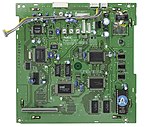PC-FX
The PC-FX was uncompelling in the marketplace due to lack of a 3D polygon-based graphics chip, high price, and limited developer support and is considered a commercial failure.
[1] The companies designed a prototype system known as "Tetsujin" ("Iron Man"), a 32-bit console with full-screen video playback, 2 megabytes of RAM, and CD-ROM.
NEC designed the console itself based on its previous experience with electronics, and Hudson provided the necessary custom chipset and co-processors.
To demonstrate the system's capabilities, Hudson created a version of Star Soldier displaying 3D objects over pre-rendered backdrops.
[1] The Tetsujin was originally set to be released in 1992, but the lack of completed games pushed the launch date to early 1993, which was also skipped.
[1] Publications speculated that the PC Engine's continued success in the market made NEC and Hudson reluctant to release a succeeding platform.
[1] The release of technologically-superior consoles in late 1993, such as the Atari Jaguar and 3DO Interactive Multiplayer, made the Tetsujin's hardware look more dated by comparison.
Presented alongside several competing systems—the PlayStation, Sega Saturn, Neo Geo CD, and Bandai Playdia—its PC tower design was met with ridicule from commentators.
In an interview roughly a year before the system launch, a representative stated that NEC had all but ruled out a release outside Japan, concluding that it would most likely sell poorly overseas due to its high price.
[10] Unlike most computer graphics accelerators of the time, (as well as arguably the most comparable device to it, the Creative Labs 3DO Blaster) the PC-FX GA outputs over a separate video connection rather than from the PC's interface itself.
Though this policy played to the hardware's strengths, it barred Hudson Soft from bringing successful PC Engine series such as Bomberman and Bonk to the PC-FX.
[13] Game Criticism writers believed the system was troubled by a weak software lineup and a lack of innovation and creativity from NEC, and served as an unsuitable and inferior follow-up to the PC Engine.



